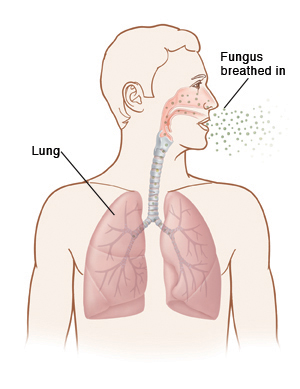Allergic Bronchopulmonary Aspergillosis (ABPA)
Your healthcare provider has told you that you have allergic bronchopulmonary aspergillosis (ABPA). This means you are having an allergic reaction to a common fungus called Aspergillus. ABPA causes the lungs to become inflamed. This leads to symptoms, such as wheezing and coughing. You may cough up a lot of phlegm or brown specks of blood. You may also develop a fever. People with asthma or cystic fibrosis are most at risk of ABPA.

What is Aspergillus?
Aspergillus is a common fungus. It is often found in soil, on plants, and in rotting vegetation. Tiny particles of the fungus can be breathed into the lungs. This doesn’t cause a problem in most people who have normal immune systems. But sometimes if you have an allergy to the fungus, it can lead to ABPA. This most often occurs in people who have asthma or cystic fibrosis.
Symptoms of ABPA
For people with asthma, the first symptoms of ABPA are often that their asthma gets worse, with wheezing and shortness of breath. Other symptoms of ABPA include:
Diagnosing ABPA
Your healthcare provider will examine you and ask about your symptoms and health history. You may also have 1 or more of these tests:
-
Skin test. This test injects a small amount of the fungus into the skin and checks it for an allergic reaction.
-
Blood test. A blood sample is taken and checked for signs of allergic reaction.
-
Sputum culture. A fluid sample is taken from the lungs and checked for fungus.
-
Imaging tests. Tests, such as a chest X-ray or CT scan, are done to take detailed pictures of the lungs.
-
Biopsy. A sample of lung tissue is taken and checked for fungus.
Treating ABPA
Corticosteroid medicines can help reduce the inflammation in your lungs. You may also be given medicines to help kill the fungus. Take these medicines exactly as directed. Call your healthcare provider if you have side effects from the medicines. Check with your pharmacist before using any over-the-counter medicines while you are getting treatment for ABPA. With treatment, symptoms linked to ABPA can be controlled in most cases. But if left untreated, ABPA can cause scarring in the lungs.
Preventing ABPA
After treatment, you will need to take steps to prevent contact with Aspergillus in the future. Wear a breathing mask when working in the garden, sweeping, or doing other tasks that could expose you to the fungus.
When to call your healthcare provider
Call your healthcare provider right away if you have any of the following:
-
Trouble breathing (call 911)
-
Fever of 100.4° F ( 38°C ) or higher, or as advised by your provider
-
Uncontrolled wheezing
-
Cough that brings up blood
-
Extreme tiredness
-
Symptoms that don’t get better with treatment or that get worse
Online Medical Reviewer:
Marianne Fraser MSN RN
Online Medical Reviewer:
Melinda Murray Ratini DO
Online Medical Reviewer:
Rajadurai Samnishanth Researcher
Date Last Reviewed:
3/1/2024
© 2000-2025 The StayWell Company, LLC. All rights reserved. This information is not intended as a substitute for professional medical care. Always follow your healthcare professional's instructions.